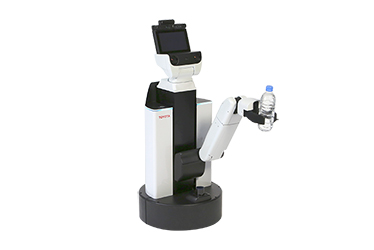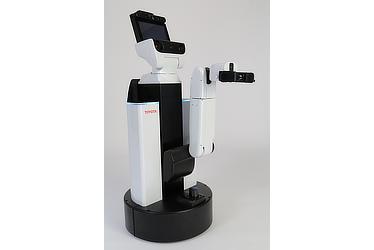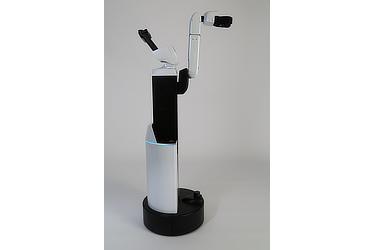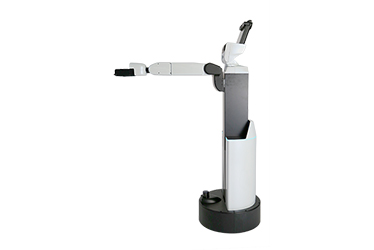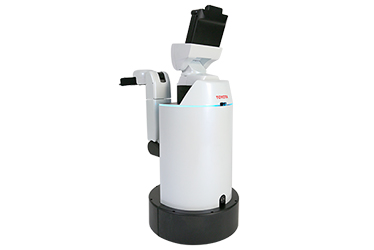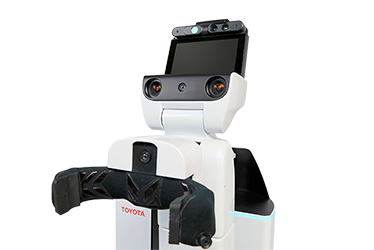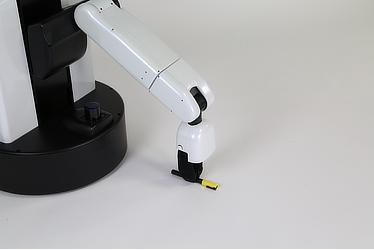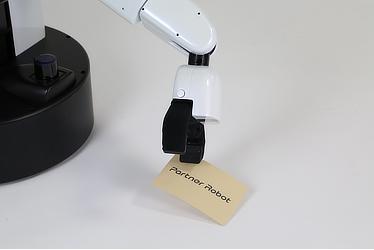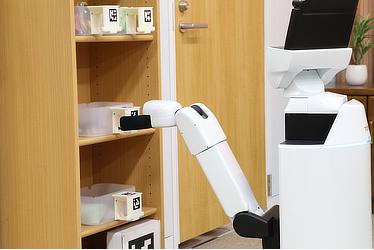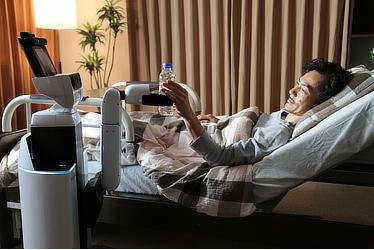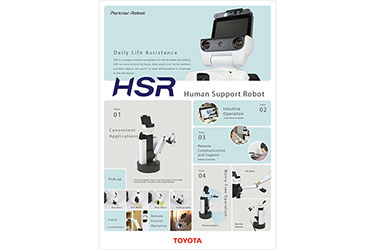Jul. 16, 2015
Toyota Shifts Home Helper Robot R&D into High Gear with
New Developer Community and Upgraded Prototype
Toyota City, Japan, July 16, 2015―The World Health Organization predicts that by 2050, 22% of the world's population will be over 60 years old1. The Japanese government estimates that by 2060, nearly 40% of Japan's population will be aged 65 or over2, requiring an ever-increasing number of long-term-care workers. This "graying" of society will affect many countries over the coming decades.
The Human Support Robot (HSR) is Toyota's answer to the ever-increasing demand for long-term elderly care in societies like Japan. With its highly maneuverable, compact, and lightweight cylindrical body and folding arm, the HSR can pick objects up off the floor, retrieve objects from shelves, and perform a variety of other tasks.
With the goal of assisting independent home living for the elderly and disabled, Toyota is teaming up with a number of research institutes to found the HSR Developers' Community. This institute will put forth a cooperative effort to hasten the development and early practical adoption of the HSR.
In caring for your loved ones, artificial intelligence is not yet a substitute for human attentiveness. In addition to local, on-site operation, the HSR can be operated remotely by family and friends, with the operator's face and voice being relayed in real-time, allowing for real, human interaction while also being able to help with daily tasks. Since it was first announced in 2012, the HSR has undergone a number of improvements based on feedback from patients and healthcare workers.
Toyota will loan HSRs to partner organizations in Japan (primarily universities, research facilities, and businesses), who will then share their software development progress and newly gained knowhow throughout the community. Toyota will also aid research institutes in HSR testing by helping to find appropriate facilities for the tests along with other supportive efforts.
Initially, starting in September, the HSR Developers' Community will consist of Toyota and several other institutions already testing the HSR. The community hopes to increase membership by around 10 groups from April 2016 onward, with applications to join the first round of HSR Developers' Community recruitment being accepted from today. Research projects are expected to last for around two years, with the possibility of extension (pending mutual agreement).
| Body diameter | 430 mm |
| Body height | 1,005 mm―1,350 mm |
| Weight | Approx. 37 kg |
| Arm length | Approx. 600 mm |
| Shoulder height | 340 mm―1,030 mm |
| Objects that can be held |
1.2 kg or less, 130 mm wide or less |
| Maximum speed | 0.8 km/h |
| Mobility | Can traverse surfaces with height difference of up to 5 mm and inclines of up to 5° |

HSR |
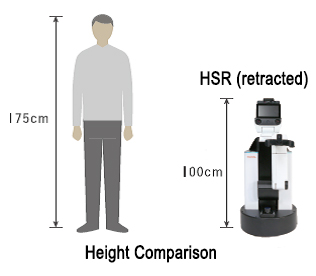 |
| Body diameter |
430 mm |
| Body height |
1,005 mm―1,350mm |
| Weight | Approx. 37 kg |
| Arm length |
Approx. 600 mm |
| Shoulder height |
340 mm―1,030 mm |
| Objects that can be held |
1.2 kg or less, 130 mm wide or less |
| Maximum speed |
0.8 km/h |
| Mobility | Can traverse surfaces with height difference of up to 5 mm and inclines of up to 5° |
Hoping to jumpstart HSR innovation, Toyota will hold a "Hackathon" at Toyota's Mega Web showroom in Tokyo, Japan from August 31 to September 2. Eight teams of five from academic, research, and corporate entities will compete to develop the most innovative application for the HSR. Winners of the event will receive an HSR development kit free-of-charge for one year.
The new Human Support Robot will be exhibited at the Yokohama Human & Technoland exhibition at Pacifico Yokohama from July 24 to 25, and at the Annual Conference of the Robotics Society of Japan at Tokyo Denki University from September 3 to 5.
Toyota's Partner Robot Division was founded in 2005 to focus on the development of robots that exist in harmony with people, assisting in their activities and mobility. We view our Partner Robots as helpful, resourceful and intelligent machines. Partner Robot development is progressing in four areas: nursing and healthcare, short-distance personal transport, manufacturing, and home-living.
For applications to join the HSR Developers' Community or participate in the HSR Hackathon,
please visit http://www.toyota.co.jp/jpn/tech/partner_robot/ (Japanese only).
To find out more about HSR development and Toyota's other robotics-related projects,
visit http://www.toyota-global.com/innovation/partner_robot/.






